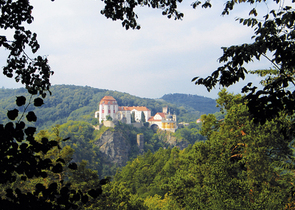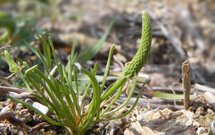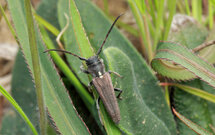Nature Conservation 2/2008 — 22. 4. 2008 — On Nature in the Czech Republic
The Podyjí/Thaya River Basin National Park
Its main aim is to protect an extraordinarily valuable area with the well-preserved deep Dyje/Thaya River valley with an adjacent complex of semi-natural and natural forests. The protected area is located on the boundary between the Bohemian Massif and the Carpathians: therefore, its geological structure is rather complex. In the western part, metamorphic rocks (phylites and gneisses) dominate, while in the central part crystallic limestones and in eas-tern part granites prevail. The National Park is situated on the edges of distribution ranges of wild plant and animal species, belonging to Central European fo-rest area as well as termophilous ones: the latter have penetrated from southeastern Europe there. The pattern resulted in one of the most remarkable National Park's features – very high wildlife species diversity and at the same time, their relatively high concentration on a relatively small area. Hardly anywhere in Central Europe, a 40 km long river valley which has been only little damaged by human activities and harbours a huge range of morphological features and terrain shapes, has been preserved. In the grandious canyon-like valley, the average depth being 150 m, there are many river meanders, talus slopes, cliffs, rock faces and pillars, an ice caves pseudokarst system and other geomorphologic phenomena. Geomorphologic structure and geological bedrock diversity determines the presence of various vegetation types, from submontane beech forests with the Common Yew (Taxus baccata) in the western part to thermophilous acidophilous oak forests with the rare Garland or Rose Daphne (Daphne cneorum) on the National Park's eastern edge. The occurrence of some perialpine species, e.g. the Purple Sowbread (Cyclamen purpurascens) as well as that of the Showy Mullein (Verbascum speciosum), also known as Hungarian Mullein, and Yellow Oxeye Daisy (Buphtalmum salicifolium), the latter preferring basiphilous oak forests in the NP's central part, should be mentioned. The similar diversity has been described also from dry grasslands, steppe remnants and dry heathlands in the eastern part, where the Heather (Calluna vulgaris) prevails, followed by conspicuous species such as the Great Pasque Flower (Pulsatilla grandis), Dwarf Iris (Iris pumilla) or Early Star-of-Bethlehem (Gagea bohemica). In total, approx. 1,300 vascular plant species have been reported from the Podyjí/Thaya River Basin National Park. The similar species richness can be found among wild animals: e.g., 65 mammalian species and more than 200 bird species, of the latter 140 nesting there. The National Park is the only site in the Czech Republic where the Asmann's Fritillary (Melitaea britomartis) and European Mantispid (Mantispa styriaca) occur. The Podyjí/Thaya River Basin National Park Administration, a governmental body in charge of the National Park's protection and management, has closely been collaborating with the Nationalpark Thayatal Administration on the Austrian side. The transboundary Podyjí–Thayatal NP is a model bilateral protected area, which was awarded by the certificate of quality within the EUROPARC Federation's initiative Transboundary Parks – following nature's design. Both the national parks have been also awarded by the European Diploma of the Council of Europe. Main environmental threats to the area include flow rate fluctuations in the Dyje/Thaya River caused by the Vranov hydroelectric power station, intensive land-use changes in the NP´s buffer zone due to agriculture production, increasing visitors´ numbers and overexploitation of the landscape resulting from adjacent human settlement development. The area is listed in the IUCN – World Conservation Union category II (“National Parks”) and therefore, its mission is to conserve natural values and to provide support to natural processes in ecosystems there.
Název připojené galerie
Quisque egestas velit non nulla fermentum, aliquet pharetra nunc malesuada. Nullam molestie vel diam non tincidunt. Sed pulvinar lacinia nunc et consectetur. Duis varius leo ac ex scelerisque, ullamcorper eleifend massa consectetur. Nullam in metus ac arcu pellentesque venenatis ac id lorem. Nulla nec ipsum sed enim sodales blandit a sit amet ex.









